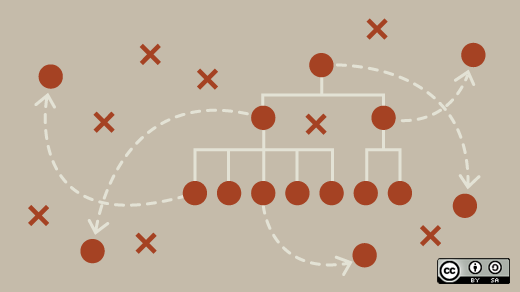One of the key tasks of management is coordinating activities--making sure the right people are working on the right projects at the right time. Most companies default to a top-down allocation system: people are put on projects according to availability, favouritism, or sometimes, pure luck. That's reasonably efficient, but the result is some lucky folks get all the exciting projects, some get stuck on a project-from-hell forever, and some never get a chance to prove themselves.
Some companies, such as Eden McCallum, the London-based strategy consultancy, have experimented with a virtual-company model in which they act as the brokers between freelance project staff on one side and clients on the other. It's a clever approach, but it provides no guarantee of work for the freelancers; and it is hard to scale, because it relies on the team in the middle making a high-quality match between freelancer and client.
This article was originally posted on the Management Innovation eXchange (MIX), an open innovation project aimed at reinventing management for the 21st century.
Another option is often called the "internal market," sitting somewhere between the traditional and the virtual models. On paper, the internal market sounds attractive: it combines the efficiency of the top-down model with the fluidity and sensitivity to employee needs of the virtual model.
But in practice... well, it turns out that there are very few examples of companies using an internal market system on a consistent basis. This is why the experiences of AdNovum are so fascinating. This Swiss software company started out with a highly unusual approach to project planning and then evolved it into a hybrid of the best of conventional practices with some key differentiating approaches.
Getting the right people on the right projects
Founded by entrepreneur Stefan Arn in Zurich in 1998, AdNovum is an established player in the provision of security and software services to clients in the financial, logistics and public sectors. For the first decade or so, AdNovum was a small software provider, living on its wits with no formal systems at all. By 2002, Arn realised he had to start thinking carefully about project planning because "I wasn't able anymore to schedule all my people on the projects. It just became too complex, keeping all my employees' skill sets on the top of my head."
Arn wanted to create a flexible system in which people could be moved quickly from one project to another as well as work on projects that excited them. "So we developed a Facebook-like system on the Web where you as an employee could portray yourself, especially your skill set, for others to review. And we encouraged people to keep their CVs and their skill sets as accurate as possible."
Armed with this wealth of information about employees, Arn figured that project managers would then be able to select the best people for each piece of work. Very quickly, the new system became something of a competition: people could apply for a project by looking at the pipeline of new projects and deciding which ones suited their skills and preferences, while at the same time project heads were calling up the people they wanted. As Arn explains, "That led to a situation like in school classes, when you try to split the class in two to have a soccer match. It was always the same people being picked first. And it was always the same people at the end, waiting to be picked." Using the data on how many times developers were asked for by projects, Arn developed a performance-based ranking, which he then posted on the Intranet for all to see. He also linked the individual's position in the ranking system with their bonus.
While this market-like system fueled the competitive instincts of the AdNovum employees, it still needed to be squared with the practical realities that some projects were more important or on tighter deadlines than others. So Arn instituted a weekly staffing meeting called Cluedo, after the famous board game, to match real delivery dates and contractual obligations with the allocations made through the internal-market system. Cluedo meetings were open to all employees, with six to 15 people typically attending. They were deliberately short--60 minutes maximum. Recalls COO Christian Crowden, "We wanted to have this open and participative approach. It was important to make sure that if people did not agree or didn't understand why they were in a project or they were reallocated, they could always come up and ask."
How well did this system work? AdNovum grew strongly over the next five years and gained a strong reputation for responsiveness, at least in part due to their innovative staffing model.
But the story doesn't stop there.
In 2007 Arn sold the company to IHAG Holding AG. Ruedi Wipf (CEO), Crowden (COO) and four colleagues took over leadership of the company while Arn moved on.
From a team of 45 people in 2002, the company now has 240 people in four locations. In a typical year there are 60-70 customer projects, as well as 20-25 internal projects running at the same time. The company's staffing challenges have grown considerably and the model has moved on accordingly. Crowden reflects on the years since Arn's departure: "The model had to evolve. It's interesting, the company has now grown considerably, and it doesn't work anymore in that flat structure where everybody applies for everything."
How has the project planning system changed? The principles are the same, but the day-to-day processes are somewhat less market-like, less openly competitive. It has also become more structured, with sophisticated software tools to make things run more smoothly.
The focal point is still the Cluedo meeting. The provisional plans are made using software tools, with 10 project managers putting together the day-to-day schedule. Then, in the meeting they discuss the subjective aspects--who is working with whom, who has asked to be moved.
Meanwhile, the Facebook-like system has lost its importance and has been replaced by a more informal process, essentially built around the project managers' strong personal knowledge of their teams' motivations and skills.
So how does the new way of working take into account the needs of programmers? Says Crowden: "There is still a lot of informal communication, with everyone in the company represented by someone in the weekly Cluedo meeting. So if someone says, 'I like to have two or three projects at the same time, otherwise I get bored,' then that can be arranged." The company also has a formal policy of rotating people. "This helps the self-actualization of people, it keeps them from being bored. And there is also an implicit internal audit, because you know, sooner or later, your office neighbor is going to be looking at that code."
The best of both worlds: a market-hierarchy hybrid
AdNovum is a classic example of a dialectic process in action. The original thesis was to allocate people to projects in a top-down way. Arn offered a compelling antithesis: create an internal market, give people a chance to put themselves forward. What we see now is a genuine synthesis: a blend of formal tools and informal discussions that gives a voice to the individual developers while still leaving the management team in control.
Synthesis doesn't emerge without some creative tension. As Arn observed, the internal-market model works well in a high-octane environment of skilled and competitive people. But it also has its flaws. Software development needs "grinders" as well as stars, and the grinders often get a raw deal when their performance is analysed in objective terms. Also, linking bonuses too closely to ranking lists means encouraging people to focus on a narrow set of behaviors, whereas there are many soft dimensions of performance, from helping colleagues to taking on the messy project no one else wants.
So, little by little, AdNovum softened the edges of its innovative project management model. "As time goes by," observes Crowden, "you automatically start realizing that certain things are of use, certain things are not really that important, and then, eventually, without really noticing it, it's like evolution." The internal-market system now works through a conversation; and that's really the only way it can work if a firm is trying to coordinate the needs of multiple clients and multiple programmers.
What's next for AdNovum? There are clearly scalability challenges with a project-planning model of this type, so in February 2011 the company introduced a new structure with smaller development pools organized by speciality--the project managers and business analysts are in one pool, the application engineers are in another, and the security and integration engineers are in a third. "In principle, we are today still doing the same thing as in the beginning," observes Crowden, "but we adapted the Cluedo meeting to our changing needs. We probably focused more on the tooling for project allocations; and the aspect of the internal marketplace, in terms of individual skills and experience, has become a secondary priority. The changes we are looking at today may allow us to return to our roots with an internal market but on a new level and based on eight years of experience."







Comments are closed.